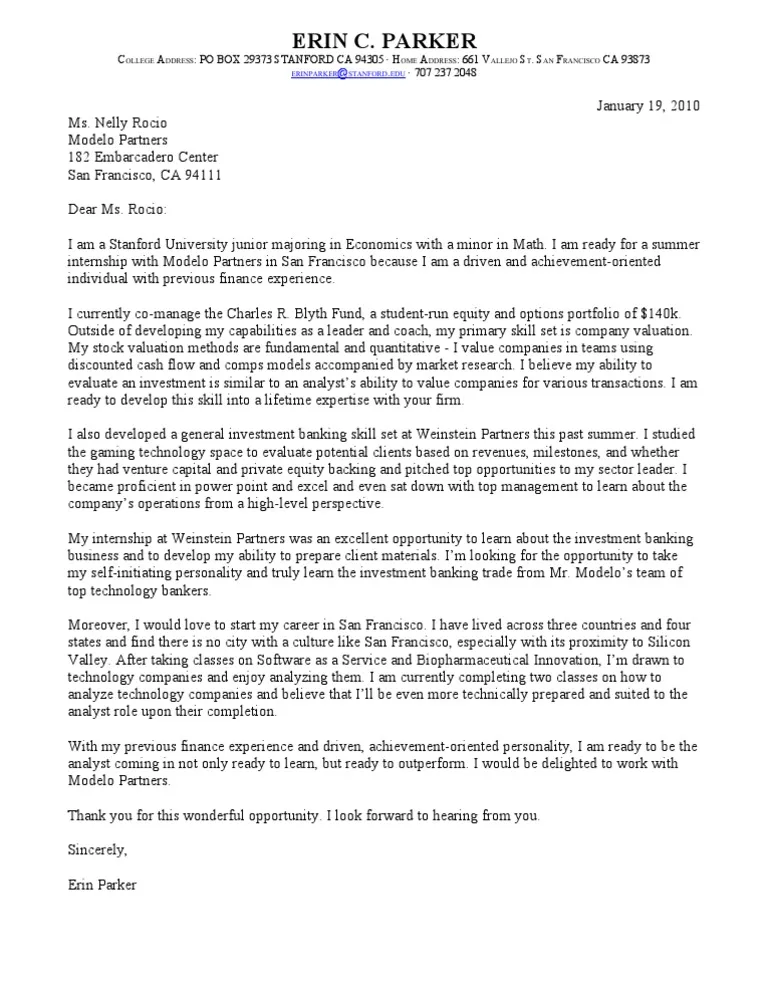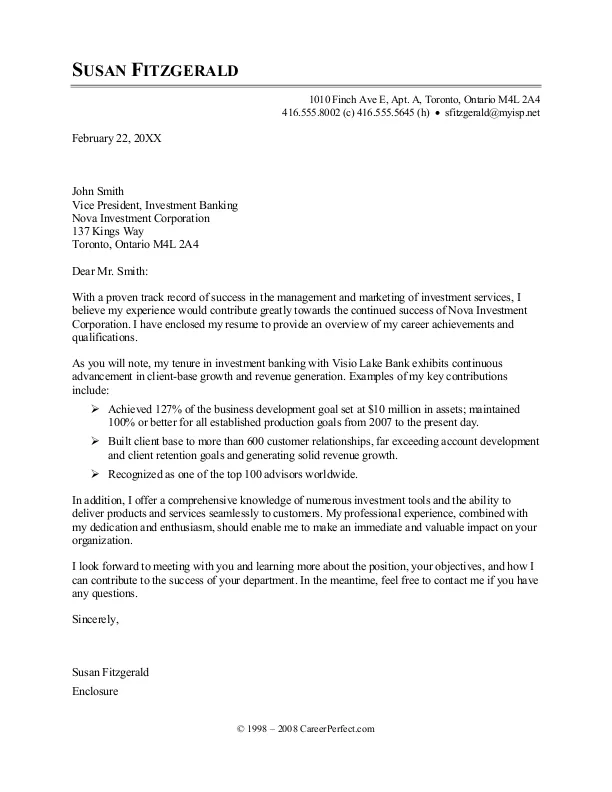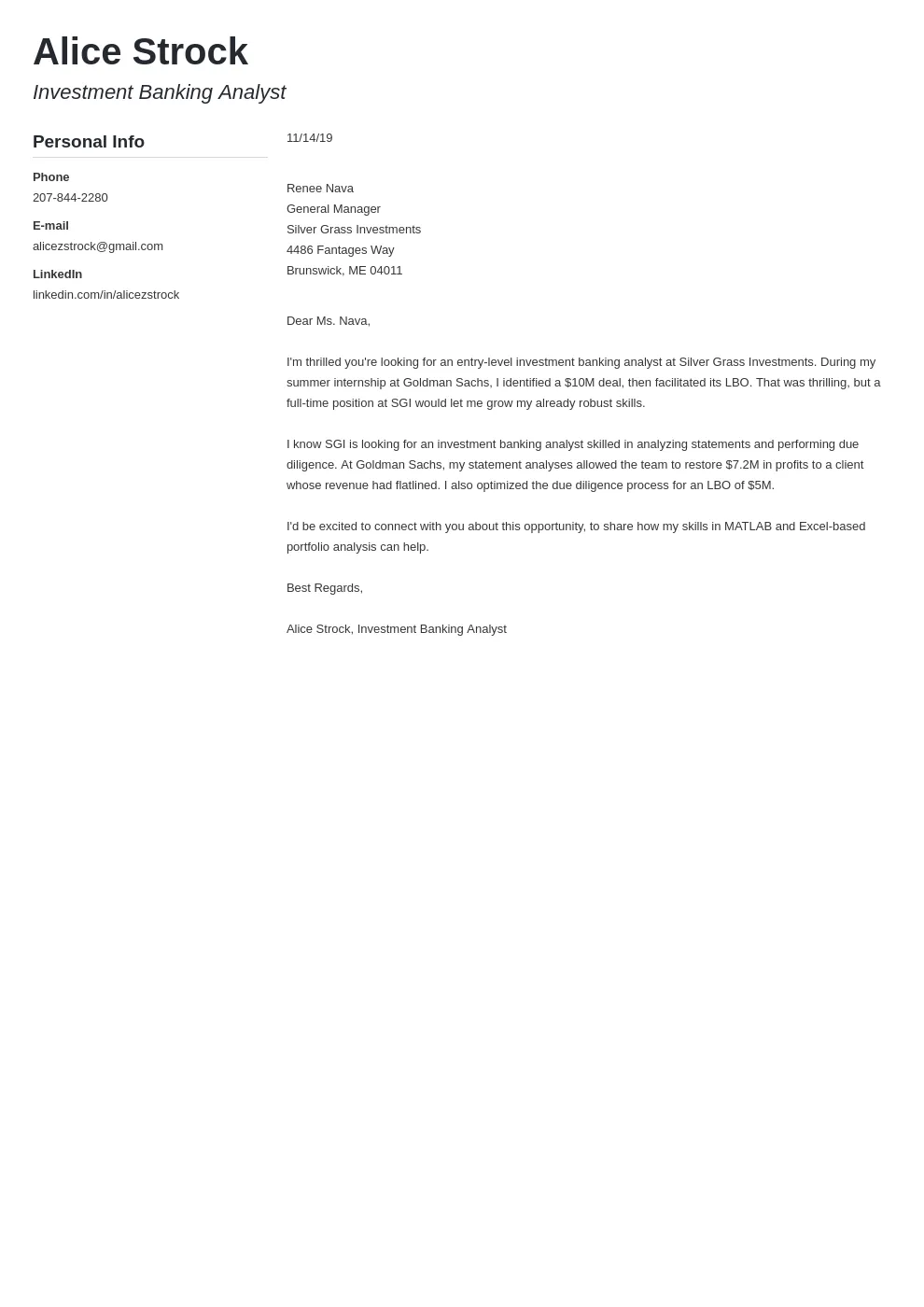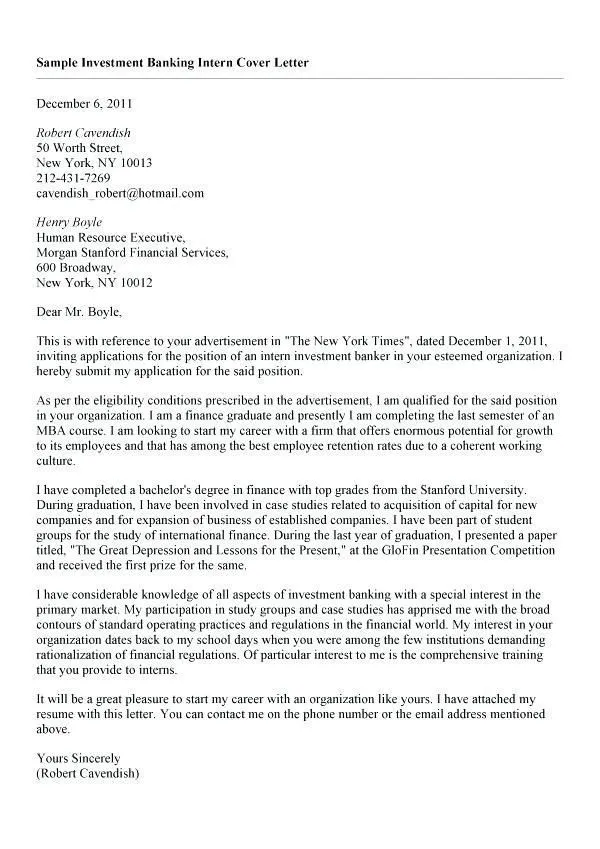Understanding the Investment Banking Cover Letter
An investment banking cover letter is more than just a formality; it’s your first opportunity to make a strong impression on potential employers. It serves as a crucial introduction, allowing you to showcase your qualifications, passion for finance, and understanding of the industry. Unlike a resume, which provides a factual overview of your experience, the cover letter allows you to articulate your motivations, connect your skills to the specific job, and demonstrate your personality. A well-crafted cover letter can significantly increase your chances of securing an interview, making it a vital component of any investment banking job application.
Key Components of a Strong Cover Letter
A compelling investment banking cover letter should include several key elements. Firstly, you must provide your contact information, followed by the recipient’s details. Next, a professional salutation sets the tone. The opening paragraph is where you grab the reader’s attention, clearly stating your interest in the role and the firm. The body of the letter should then highlight relevant skills and experiences, quantifying your achievements whenever possible. Tailoring the letter to the specific role and company is essential, demonstrating your knowledge and enthusiasm. Finally, a strong closing reiterates your interest and includes a call to action.
Contact Information

Begin your cover letter by including your contact information at the top. This should include your full name, phone number, email address, and LinkedIn profile URL (if applicable). Ensure that your email address is professional and that your voicemail message is also professional. This ensures that the recruiter can easily reach out to you if they are impressed by your application. Ensure the information is accurate and up-to-date to avoid any missed opportunities.
The Recipient’s Information
Direct your cover letter to the hiring manager or the specific recruiter if possible. Research the company’s website or LinkedIn to find out the correct name and title. Addressing the letter to a specific person demonstrates that you have taken the initiative to learn more about the company and the role. If you can’t find a specific name, ‘Dear Hiring Manager’ is an acceptable alternative. This personal touch can make your application stand out from the crowd.
The Salutation
Start your cover letter with a professional salutation. ‘Dear Mr./Ms. [Last Name]’ is a standard and appropriate option. If you’re unsure of the recipient’s gender, ‘Dear [First Name] [Last Name]’ is a safe choice. Avoid overly casual greetings. A well-chosen salutation immediately sets a tone of professionalism and respect, which is crucial for an investment banking application. It helps create a positive first impression.
Crafting a Compelling Opening

The opening paragraph is your chance to capture the reader’s attention. Start by clearly stating the position you are applying for and where you saw the job posting. Briefly mention your strong interest in the role and the company. Highlight a key skill or experience that aligns with the job requirements. This initial paragraph should be concise and focused, leaving a positive and memorable first impression. Show genuine enthusiasm for the opportunity and the firm.
Highlighting Your Interest in Investment Banking
Expressing your genuine interest in investment banking is crucial. Explain why you’re drawn to the industry. Discuss what excites you about finance, deal-making, and providing financial advice. Mention specific aspects of investment banking that resonate with you, such as mergers and acquisitions (M&A), initial public offerings (IPOs), or financial modeling. Your enthusiasm should be evident, demonstrating your passion and commitment to a career in investment banking, signaling your seriousness about the role.
Demonstrating Relevant Skills and Experiences
Focus on skills and experiences most relevant to the investment banking role. Highlight any coursework, projects, or internships that demonstrate financial knowledge, analytical skills, and understanding of financial statements. Mention your experience with financial modeling, valuation, and deal structuring if possible. Tailor this section to the specific requirements outlined in the job description, showing that you understand the role’s expectations and how your experience aligns with them.
Quantifying Achievements

Whenever possible, quantify your achievements. Instead of simply stating that you ‘assisted with financial analysis,’ provide specific examples. For instance, mention the number of deals you worked on, the value of transactions you helped analyze, or any improvements you brought about through your work. Use numbers and data to demonstrate the impact of your contributions. This adds credibility to your claims and makes your cover letter more persuasive.
Showcasing Financial Acumen
Demonstrate your financial acumen. Highlight your knowledge of financial concepts, such as discounted cash flow (DCF) analysis, valuation techniques, and market trends. Discuss any projects or experiences where you utilized these skills. Mention any relevant certifications or coursework, such as the Chartered Financial Analyst (CFA) or a finance degree. This showcases your commitment to the field and expertise. Mention any experience with financial software or databases.
Highlighting Leadership and Teamwork
Investment banking requires strong leadership and teamwork skills. Provide examples of your leadership abilities, such as leading a team on a project or taking initiative in a group setting. Highlight your experience working collaboratively, resolving conflicts, and contributing to a team’s success. Mention any extracurricular activities, such as student organizations or sports teams, that demonstrate these skills. Showcase your ability to work well with others and lead effectively.
Tailoring Your Letter to the Specific Role

Customize your cover letter for each specific job application. Review the job description carefully and identify the key requirements and skills. Tailor your letter to address these points directly, highlighting relevant experiences and skills. This demonstrates that you understand the role and are a good fit for the company. Generic cover letters are easily identified and are likely to be overlooked. Tailoring your letter shows that you have taken the time and effort to personalize your application.
Researching the Company and Role
Conduct thorough research on the company and the specific role. Learn about the firm’s recent deals, its culture, and its values. Understand the responsibilities of the position and the skills required. Mention any specific projects or initiatives the company is involved in. This demonstrates your initiative and interest in the company. It shows that you are serious about the role and want to contribute to the company’s success.
Addressing Specific Requirements
Carefully address any specific requirements mentioned in the job description. This could include specific skills, software knowledge, or certifications. Make sure your cover letter reflects these requirements. If the job posting mentions particular qualifications or experiences, be sure to address them. If the job description requests specific information, include it to show that you meet the criteria. Doing so increases your chances of being considered.
The Body of Your Cover Letter

The body of your cover letter is where you expand on your qualifications and experiences. Use clear and concise language. Focus on highlighting your relevant skills and experiences that align with the job requirements. Provide specific examples and quantify your achievements whenever possible. Structure your paragraphs logically to improve readability and make it easy for the recruiter to follow your key points. This section must provide compelling evidence of your suitability for the role.
Structuring Your Paragraphs
Organize your paragraphs in a logical and coherent manner. Start with a topic sentence that introduces the main idea of the paragraph. Provide supporting details, such as specific examples, quantifiable achievements, and relevant experiences. Use transition words and phrases to connect ideas and create a smooth flow. Ensure each paragraph contributes to the overall narrative of your cover letter and highlights your qualifications effectively. A well-structured cover letter is easier to read and more impactful.
Providing Concrete Examples
Support your claims with concrete examples. Rather than simply stating that you are a strong analyst, describe a project where you used your analytical skills. Provide specific details about the project, your role, and the results you achieved. Use the STAR method (Situation, Task, Action, Result) to structure your examples and provide a clear and compelling narrative. This approach demonstrates your capabilities and provides evidence of your skills.
The Closing of Your Cover Letter

The closing paragraph is your final opportunity to leave a positive impression. Express your enthusiasm for the opportunity and reiterate your interest in the role and the company. Thank the reader for their time and consideration. Include a call to action, such as requesting an interview or expressing your willingness to provide further information. Keep the closing concise and professional, reiterating your interest and showcasing your positive attitude.
Expressing Enthusiasm and Gratitude
Reiterate your enthusiasm for the opportunity and the company. Show that you’re genuinely excited about the possibility of joining the team. Thank the reader for their time and consideration, and express your appreciation for the opportunity. A positive closing strengthens your application and makes a memorable impression. A genuine and enthusiastic tone can significantly enhance your chances of success.
Including a Call to Action
Include a clear call to action in your closing paragraph. Express your desire for an interview. State that you are available for an interview at their earliest convenience. Providing your contact information again ensures that the recruiter can quickly reach out to you. A call to action demonstrates your proactivity and interest in the position, showing that you’re eager to take the next step in the hiring process.
Formatting and Proofreading Your Cover Letter

Formatting and proofreading are critical aspects of a successful cover letter. Ensure your letter is visually appealing, professional, and free of errors. A well-formatted and error-free cover letter shows attention to detail and professionalism. Poor formatting and typos can detract from your qualifications. Take the time to perfect these details before submitting your application.
Choosing the Right Font and Format
Choose a professional and easy-to-read font, such as Times New Roman, Arial, or Calibri. Use a standard font size (11 or 12 points). Maintain consistent formatting throughout the letter, including consistent margins, spacing, and alignment. Use a clear and professional format that enhances readability. Ensure your cover letter is easy to read and visually appealing. Make sure the letter is well-organized and reflects a professional image.
Proofreading for Errors
Proofread your cover letter meticulously for any grammatical errors, spelling mistakes, or typos. Use spell-check and grammar-check tools. Read the letter aloud to catch any awkward phrasing or inconsistencies. Ask a friend, family member, or career advisor to review your cover letter for feedback. A polished and error-free cover letter demonstrates attention to detail and reflects positively on your professionalism, increasing the chances of a positive response.
Reviewing and Refining Your Letter
After completing your cover letter, take the time to review and refine it. Ensure that your letter is concise, clear, and persuasive. Make sure your letter is tailored to the specific job and company. Revise your cover letter to remove any unnecessary words or phrases. Seek feedback from career advisors or mentors to improve your application. Refinement is essential to create a strong and successful application. Continuously improve and refine your cover letter to increase your chances of success.
